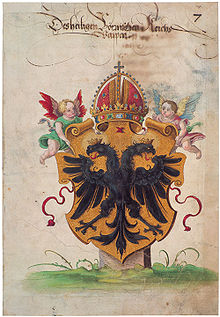German heraldry

Manuscript illumination of historical arms of the Holy Roman Empire, ca.1540
|
|
| Heraldic tradition | German-Nordic |
|---|---|
| Governing body | [[]] |
German heraldry refers to the cultural tradition and style of heraldic achievements in modern and historic Germany and the Holy Roman Empire, including national and civic arms, noble and burgher arms, ecclesiastical heraldry, heraldic displays and heraldic descriptions. German heraldic style is one of the four major broad traditions within European heraldry and stands in contrast to Gallo-British, Latin and Eastern heraldry, and strongly influenced the styles and customs of heraldry in the Nordic countries, which developed comparatively late. Together German and Nordic heraldry are often referred to as German-Nordic heraldry. The German heraldic tradition is noted for its scant use of heraldic furs, multiple crests, inseparability of the crest, and repetition of charges in the shield and the crest. Mullets have six points (rather than five as in Gallo-British heraldry), and beasts may be colored with patterns, (barry, bendy, paly, chequy, etc.). As in other European heraldic traditions, the most prominent among the birds and beasts are the eagle and lion. These two charges in particular had a special significance in Germany, where the eagle became symbolic of the Holy Roman Empire, and the lion came to represent certain feudal lords. As the political divide between these groups grew in the late Middle Ages, the heraldic eagle and lion came to represent two of the foremost political powers in Germany, the house of Hohenzollern and the house of Welf, respectively.
The heraldic tinctures are the same in Imperial heraldry as in other European countries. Black charges occur on red fields and vice versa more often than in other countries, as in the arms of Stadler, Roder and Homberg. Tinctures are described using the German words for each (i.e. schwarz for sable, rot for gules, gold for Or, etc.), and argent is usually called silber (silver) though weiß (white) also occurs. The furs are referred to as follows: Ermine is Hermelin, Ermines (or counter-ermine) is Gegenhermelin, Erminois is Goldhermelin, Pean is Gegengoldhermelin, Vair is Feh or Grauwerk, Countervair is Gegenfeh, and Vairy of (tincture) and (tincture) is Buntfeh ob (tinktur) und (tinktur).
...
Wikipedia
